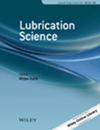Formulation and tribological performance of engine oil blended with various non-edible vegetable oils
IF 1.9
4区 工程技术
Q3 ENGINEERING, CHEMICAL
引用次数: 1
Abstract
This present study formulated eco‐friendly lubricants by combining non‐edible vegetable oils with a mineral oil and investigated their efficacy on the friction and wear characteristics of four AISI 52100 chrome steel balls. Multiple formulations containing varying combinations of 0 to 100 vol% of a mineral oil SAE 15W40 (S100), castor oil (C100), and jatropha oil (J100) were prepared using the sonification technique in an ultrasonic homogeniser. A fourier transform spectrometer (FTIR) was then used to investigate the molecular vibrations of each formulation. A tribological test was also performed with a four‐ball tribometer according to ASTM D4172‐94 engineering standards. Finally, a scanning electron microscope (SEM) equipped with an energy dispersive X‐ray spectroscope (EDX) was used to examine surface morphologies. The 80% S100, 10% C100, and 10% J100 (S80C10J10) formulation provided excellent tribological performance as it contained fatty acids composed of carbohydrates and carbonyl groups, particularly polysaccharides and glycerols.与各种非食用植物油混合的发动机油的配方和摩擦学性能
本研究通过将非食用植物油与矿物油相结合,配制了环保型润滑剂,并研究了它们对四个AISI 52100铬钢球摩擦磨损特性的影响。多种配方,包含0到100的不同组合 在超声波均化器中使用超声处理技术制备体积%的矿物油SAE 15W40(S100)、蓖麻油(C100)和麻疯树油(J100)。然后使用傅立叶变换光谱仪(FTIR)来研究每种制剂的分子振动。根据ASTM D4172-94工程标准,还使用四球摩擦计进行了摩擦学试验。最后,使用配备有能量色散X射线光谱仪(EDX)的扫描电子显微镜(SEM)来检查表面形貌。80%的S100、10%的C100和10%的J100(S80C10J10)配方提供了优异的摩擦学性能,因为它含有由碳水化合物和羰基组成的脂肪酸,特别是多糖和甘油。
本文章由计算机程序翻译,如有差异,请以英文原文为准。
求助全文
约1分钟内获得全文
求助全文
来源期刊

Lubrication Science
ENGINEERING, CHEMICAL-ENGINEERING, MECHANICAL
CiteScore
3.60
自引率
10.50%
发文量
61
审稿时长
6.8 months
期刊介绍:
Lubrication Science is devoted to high-quality research which notably advances fundamental and applied aspects of the science and technology related to lubrication. It publishes research articles, short communications and reviews which demonstrate novelty and cutting edge science in the field, aiming to become a key specialised venue for communicating advances in lubrication research and development.
Lubrication is a diverse discipline ranging from lubrication concepts in industrial and automotive engineering, solid-state and gas lubrication, micro & nanolubrication phenomena, to lubrication in biological systems. To investigate these areas the scope of the journal encourages fundamental and application-based studies on:
Synthesis, chemistry and the broader development of high-performing and environmentally adapted lubricants and additives.
State of the art analytical tools and characterisation of lubricants, lubricated surfaces and interfaces.
Solid lubricants, self-lubricating coatings and composites, lubricating nanoparticles.
Gas lubrication.
Extreme-conditions lubrication.
Green-lubrication technology and lubricants.
Tribochemistry and tribocorrosion of environment- and lubricant-interface interactions.
Modelling of lubrication mechanisms and interface phenomena on different scales: from atomic and molecular to mezzo and structural.
Modelling hydrodynamic and thin film lubrication.
All lubrication related aspects of nanotribology.
Surface-lubricant interface interactions and phenomena: wetting, adhesion and adsorption.
Bio-lubrication, bio-lubricants and lubricated biological systems.
Other novel and cutting-edge aspects of lubrication in all lubrication regimes.
 求助内容:
求助内容: 应助结果提醒方式:
应助结果提醒方式:


